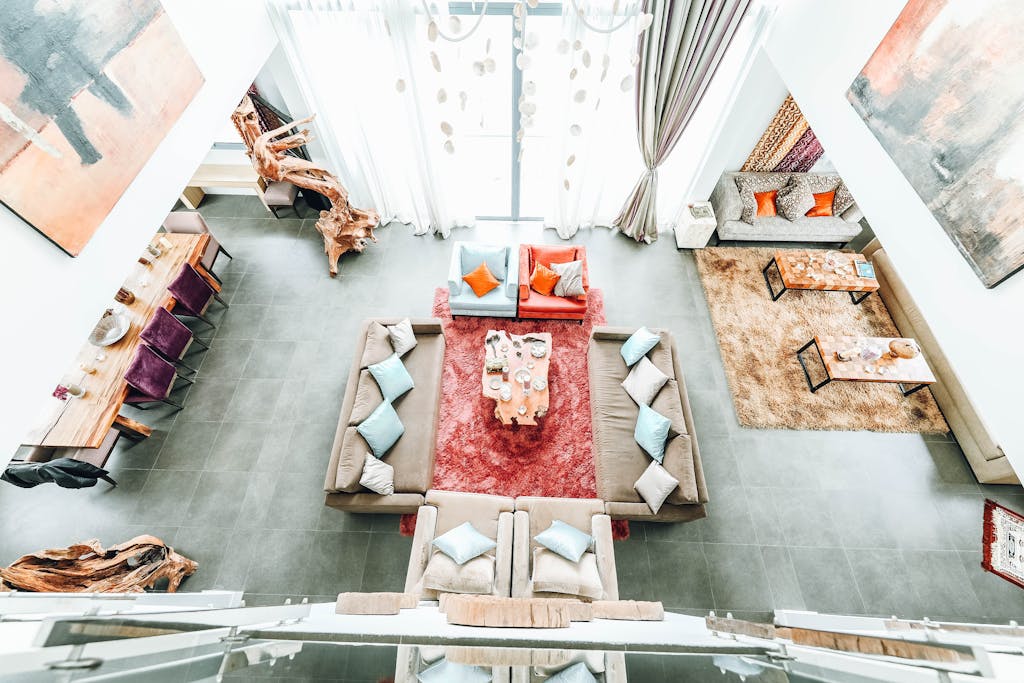Modern interior design is constantly evolving, with two opposing styles gaining popularity—minimalism and maximalism. While minimalism embraces simplicity, clean lines, and a “less is more” approach, maximalism celebrates bold colors, rich textures, and an abundance of décor. Each trend offers unique benefits and aesthetic appeal, shaping how people design their homes.
The Philosophy Behind Minimalism
Minimalism is rooted in the idea that simplicity enhances functionality and well-being. Inspired by Japanese aesthetics and modernist design, this style focuses on decluttering spaces and using only essential items.
Key Characteristics of Minimalist Interiors
Neutral Color Palette
Minimalist spaces often feature white, beige, gray, and other muted tones to create a calming atmosphere.
Functional Furniture
Every piece of furniture serves a purpose, with sleek, simple designs that prioritize utility over decoration.
Open and Airy Spaces
Minimalist interiors avoid overcrowding, using open floor plans, ample natural light, and strategic placement of furniture.
Decluttered Surfaces
Minimalism emphasizes a “less is more” philosophy by keeping surfaces free of unnecessary items.
High-Quality Materials
Instead of excessive decorations, minimalism relies on high-quality materials such as wood, stone, and glass to add texture and interest.

The Appeal of Maximalism
In contrast, maximalism embraces the philosophy of “more is more.” This bold design approach allows homeowners to express their personalities through layers of colors, textures, and décor.
Key Characteristics of Maximalist Interiors
Vibrant Color Schemes
Maximalist spaces often feature bright, contrasting colors such as deep blues, emerald greens, and rich reds.
Layered Textures and Patterns
Mixing different fabrics, wallpapers, and patterns creates visual interest and depth.
Eclectic Furniture and Décor
Maximalism encourages mixing styles, incorporating vintage, modern, and artistic pieces in one space.
Personalized and Collected Look
Maximalist interiors showcase personal collections, artwork, and statement pieces, reflecting the owner’s tastes and experiences.
Bold and Dramatic Design Choices
Statement lighting, large-scale artwork, and intricate details are common in maximalist homes.
Minimalism vs. Maximalism: Which One Suits Your Home?
Choosing between minimalism and maximalism depends on personal preference, lifestyle, and space constraints.
Minimalism Works Best If:
- You prefer a calm, organized environment.
- You appreciate neutral tones and simple designs.
- You value functionality and ease of maintenance.
- You live in a smaller space where clutter can feel overwhelming.
Maximalism Works Best If:
- You love bold colors and expressive interiors.
- You enjoy collecting art, books, or decorative pieces.
- You want your space to reflect a dynamic personality.
- You have a larger home that can accommodate multiple design elements.

How to Blend Minimalism and Maximalism
Some homeowners prefer a balanced approach, incorporating elements from both styles.
Use a Neutral Base with Bold Accents
Start with a minimalist foundation and introduce maximalist décor elements such as vibrant rugs, patterned pillows, or statement artwork.
Mix Textures and Materials
Combine sleek minimalist furniture with maximalist textures like velvet, leather, or intricate wallpaper.
Curate Instead of Clutter
Choose meaningful, statement pieces rather than filling a space with excessive décor.
Balance Negative and Positive Space
Ensure that there is breathing room between furniture and decorations to prevent overwhelming the space.
Conclusion
Minimalism and maximalism both offer unique ways to design a home. While minimalism creates a serene, clutter-free environment, maximalism celebrates individuality and creative expression. Whether you prefer the simplicity of minimalism or the vibrancy of maximalism, your home should reflect your personality and comfort.
